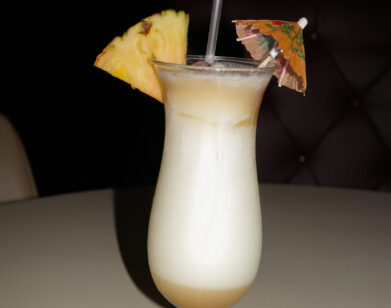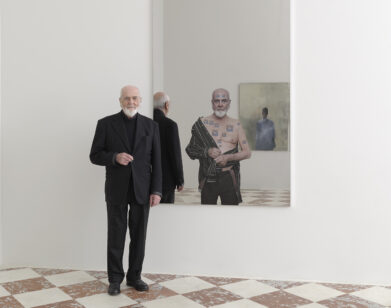Sculptor Nancy Grossman Tells Yvonne Rainer About Her 50 Years of Crafting Radical Human Shapes
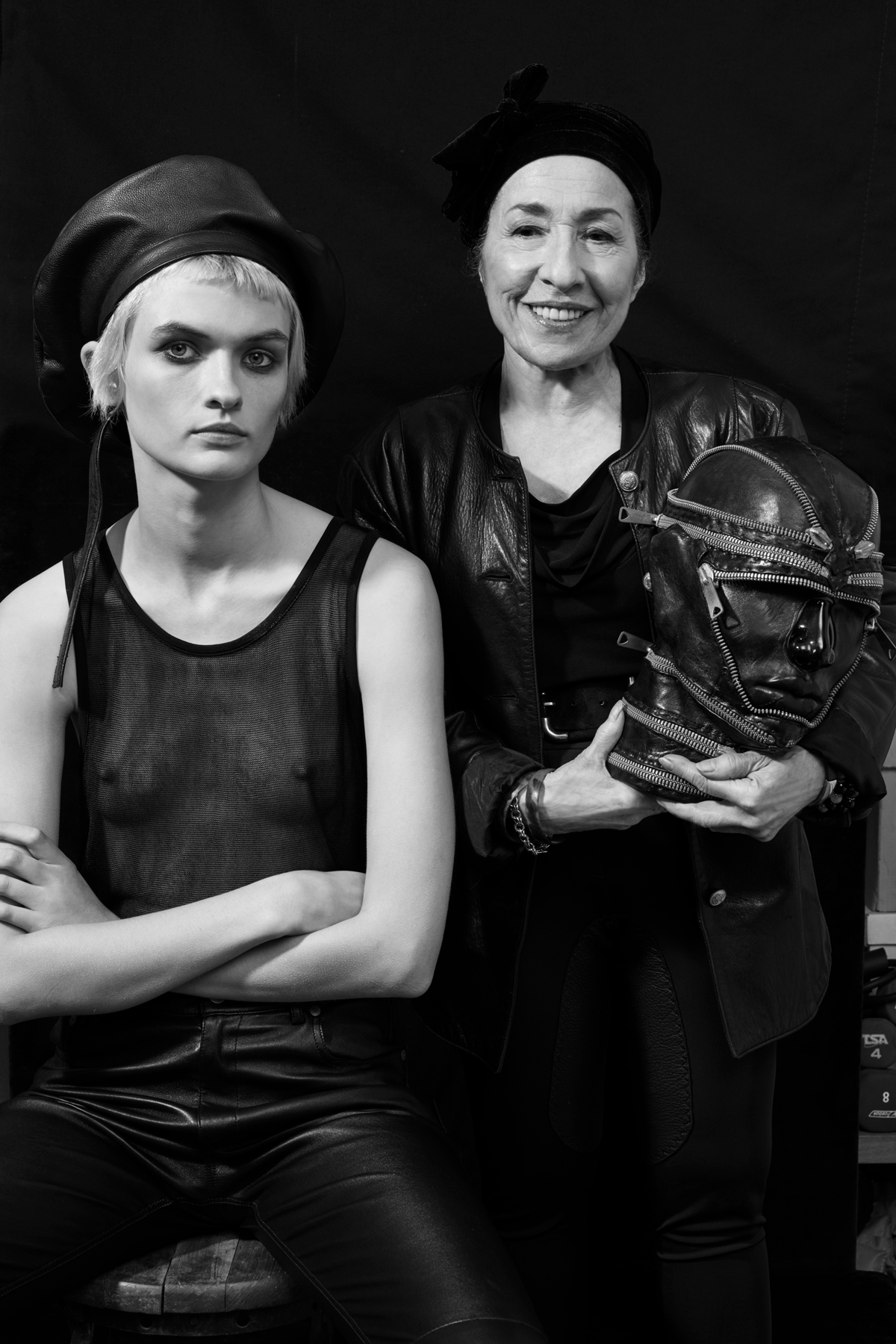
Lara wears Vintage Tank by Versace. Vintage Pants by Helmut Lang from David Casavant Archive. Hat by Charles Jeffrey Loverboy.
Fifty years ago, Nancy Grossman created her first iconic head—a radical figurative sculpture incorporating black leather, wood, metal, epoxy, and thread. That original work quickly evolved into an ongoing series, numbering roughly 100 in total, that the 78-year-old artist continues to produce in her Brooklyn studio to this day. The earliest heads were forged out of found material such as leather from a motorcycle jacket or a pair of boots and wood from a fallen telephone pole. Grossman often thought of them as self-portraits or symbolic surrogates, and as the heads progressed over the years, she introduced various embellishments: buckles, zippers, straps, horns, teeth, eyes, guns. Each head evokes a spectrum of extreme, conflicting emotions: freedom and confinement, a second skin and raw nerves, violence and restraint, agony and mastery, the exotic and the domesticated. Grossman was born in New York City, grew up on a farm upstate, and returned to study art in the city during the apogee of abstract expressionism. In that mid-century male-centric sphere, the prodigiously talented young artist, alongside female peers such as Lee Bontecou and Eva Hesse, forged her own path using provocative, unconventional materials and complex, tactile forms. Throughout her long career—in painting, collage, sculpture, drawing, and prints—Grossman has continually invested in the fantastic possibilities of the human shape—an arena for dreams and nightmares grafted onto the body like skin. To commemorate a half-century of her heads, the artist spoke with her longtime friend, the New York performance artist Yvonne Rainer.
———
YVONNE RAINER: I have a sore thumb, which comes from daily overuse. But never have I heard you mention the wear and tear on your hands in dealing with these intractable materials. So, tell me: How are your hands doing?
NANCY GROSSMAN: My left hand—I’m left-handed—hurts every day now. Actually, one time I said to Lowery [Sims, the art historian and curator], “I guess it’s over for me. I’m not going to be able to do sculpture anymore.” And she said, “Well, if you can’t use your hands anymore, use your feet!”
RAINER: That’s heartless!
GROSSMAN: But you know what? That’s exactly what one does! One does what one has to do.
RAINER: I want to ask about your heads. I noticed that a lot of them have no eyes.
GROSSMAN: That might be because, for the later ones, I became more interested in the sculpture. Making a sculpture whets your appetite for the next thing you can do, and you can get stuck trying to put everything in one piece. It reminds of this time in the 1960s, probably the end of 1963, when I had a storefront on Elizabeth Street and [the artist] David Smith was visiting. I was having so much trouble with this painting. The storefront was 60 feet long and 11 feet wide, like a subway car—I would paint in the front part, store paintings in the middle, and the last 15 feet were my living quarters. He was telling me about a show he was doing and then he broke off and said, “You know that painting of yours in the front studio? There are about 15 paintings on that canvas.”
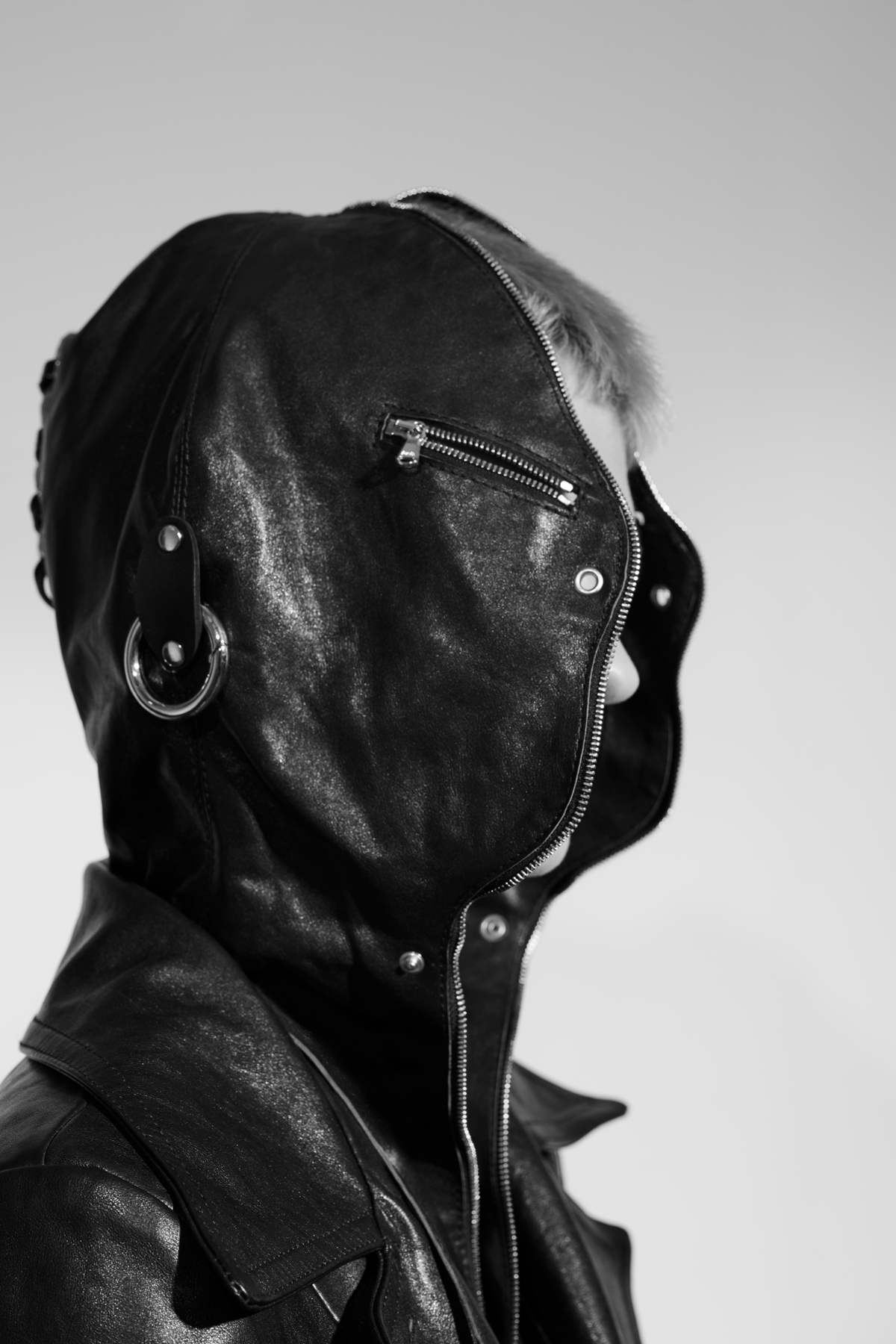
Lara wears Coat by Vetements.
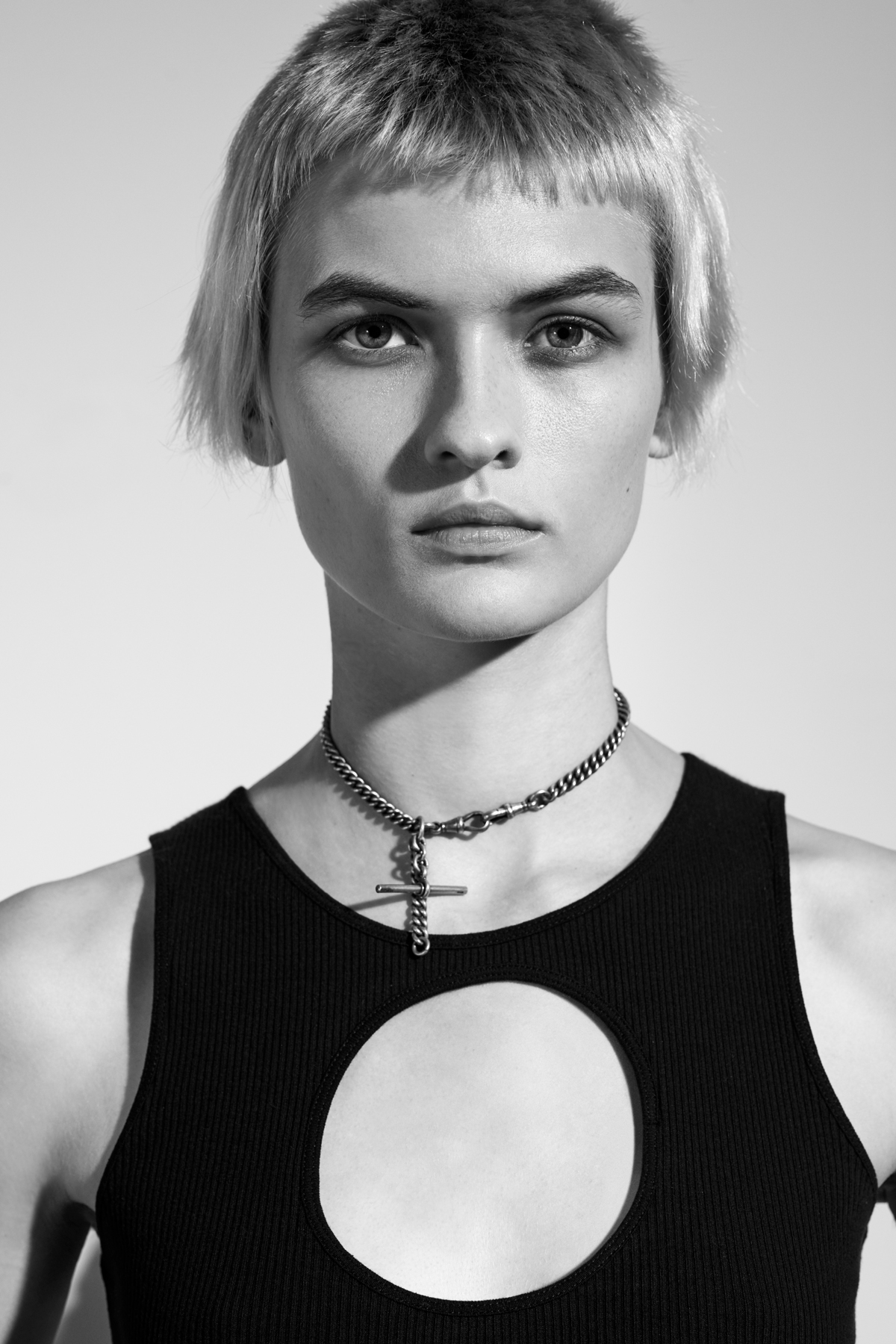
Lara wears Tank Top by Vetements. Necklace from Love Adorned.
RAINER: Even with your two-dimension works, such as the wall collages, it’s like there are 10 ideas there. You are not a minimalist, let’s put it that way.
GROSSMAN: It would be so unsatisfying for my soul. But it is a great exercise. Early on, I’d done some things with just brushes and two colors of watercolor. They were the skeletons of everything I would do later. What happened with those collages is the same thing that happened with the heads. There was a concentration of feelings that were really important for me to make as statements. I’m not saying those statements were received or even understood or addressed by an audience, but I was putting it all out there.
RAINER: I know that you consider your heads self-portraits, but I want to know why. They seem to me like some kind of commentary on male power. This might be a long shot, but are they statements about revenge?
GROSSMAN: You could say that the whole course of my life is about being elusive, and not getting trapped by the very things that trap women. What I love about your work is that you did that from the beginning. Whether people related to it or not, you made monumental artwork the way you wanted to do it. The best way to be happy in your life, and to have less pain, is to do what you want to do.
RAINER: We were privileged that we were able to do that in some way, by hook or by crook.
GROSSMAN: Those first works were really important to me. Maybe those heads are about power. Maybe they’re about male power’s envy of women. They do look ferocious.
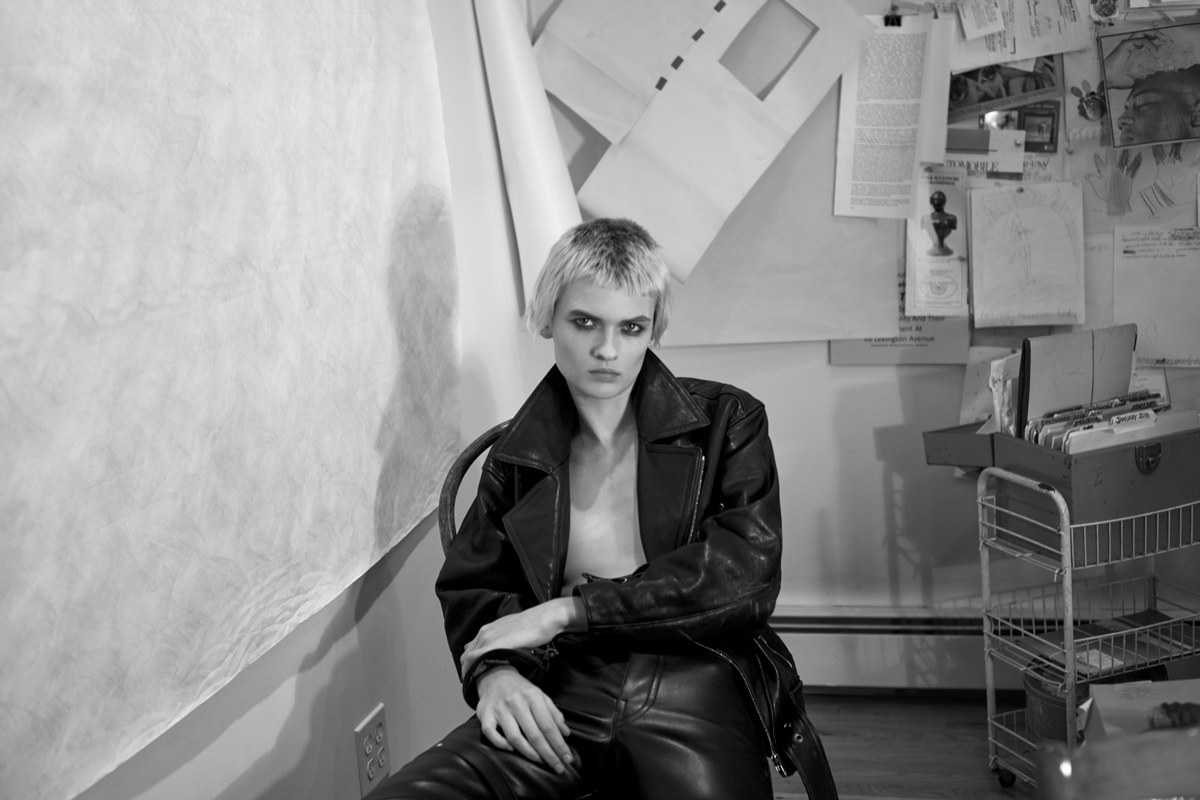
Lara Wears Jacket by Gucci. Pants by Kwaidan Editions.
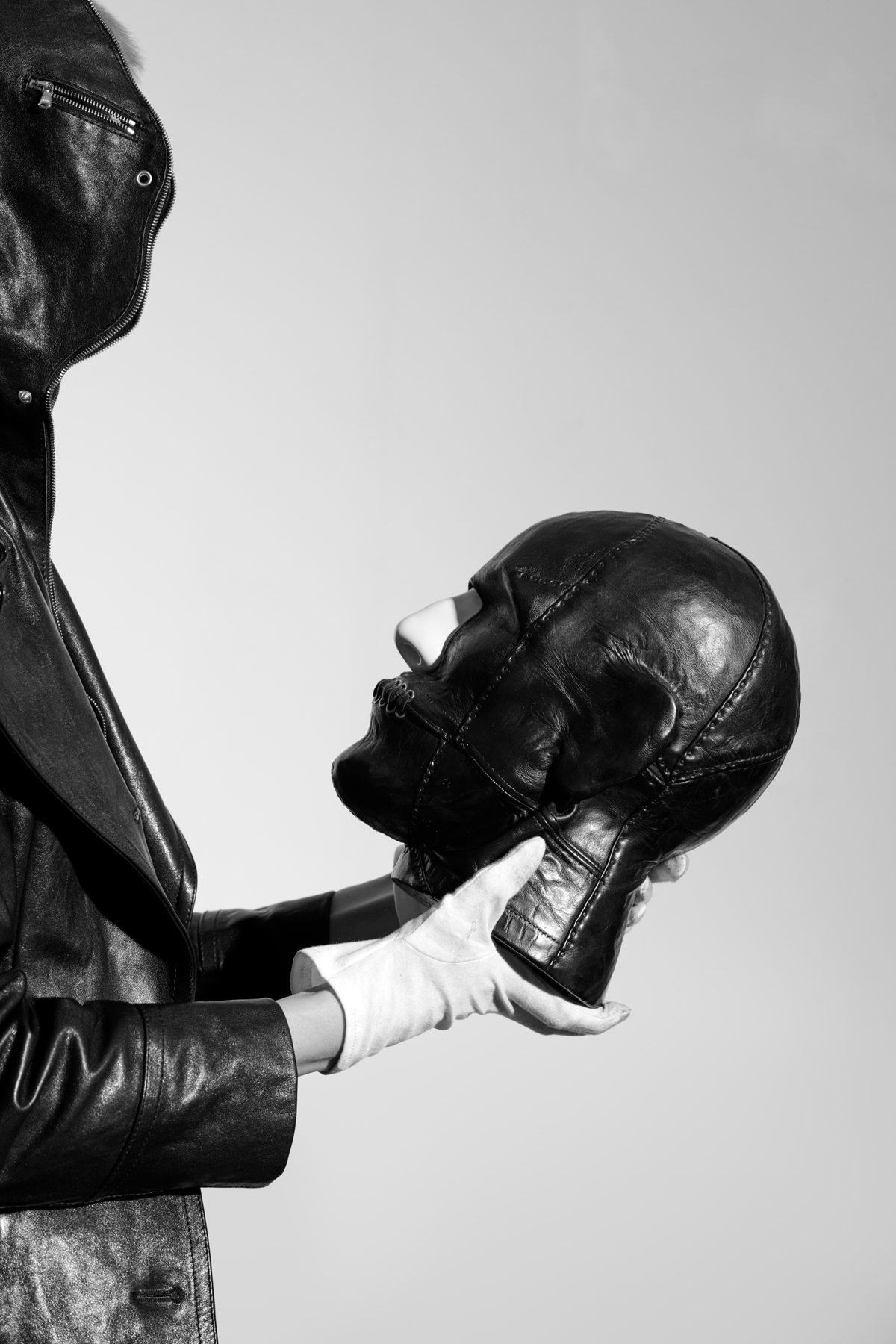
Lara wears Coat by Vetements.
RAINER: Whatever the power structure going on in them, you restrain that power. You are binding or preventing the enactment of power. That’s the way I read them anyway.
GROSSMAN: You know, I just noticed in the past couple of years how short I am. I always thought I was as tall as everybody else. I was always stronger than everyone else and I could sustain everything longer, so I never thought of my size. I’m so little that I should have been afraid, but I was so fierce and had so many big battles, many of which I’ve won.
RAINER: Are you talking about art-world battles?
GROSSMAN: Personal battles, but art-world ones, too! “You want to be a woman? Well, that comes with a foot on top of your head. My foot on your head.” I actualized these incredibly abstract ideas by physicalizing them. You did that, too.
RAINER: I’m trying to think of a comparison between using the body and using materials like leather and wood. I used the limits of my body. And powerful images can come out of using limits.
GROSSMAN: One thing I was always faithful to was my work. I didn’t even think it was okay for artists to make a living from their real work. The real work is the real work, and nobody has to be invested in it. You don’t try to customize it for anyone. You know, I taught myself sculpture from scratch, after painting. What happens so often, especially when you’re good at something, is that people put you into categories. It’s like actors playing the bad guy and so it becomes the only role people think that he or she can do. They get cornered. A lot of the work that I do is about not being cornered because the beginnings of my life were cornered.
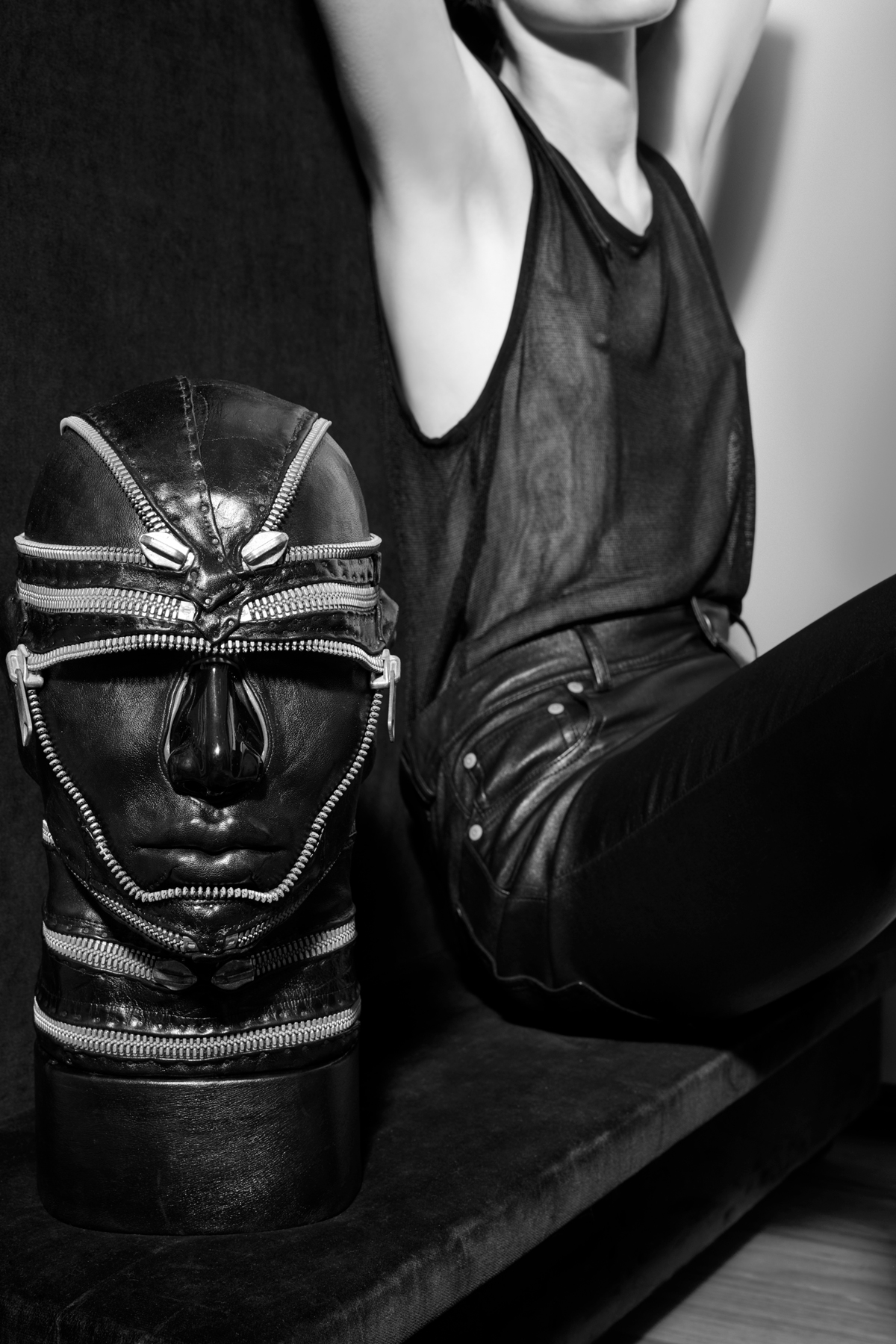
Lara wears Vintage Tank Top by Versace. Vintage Pants by Helmut Lang from David Casavant Archive. “Black,” 1973-74.
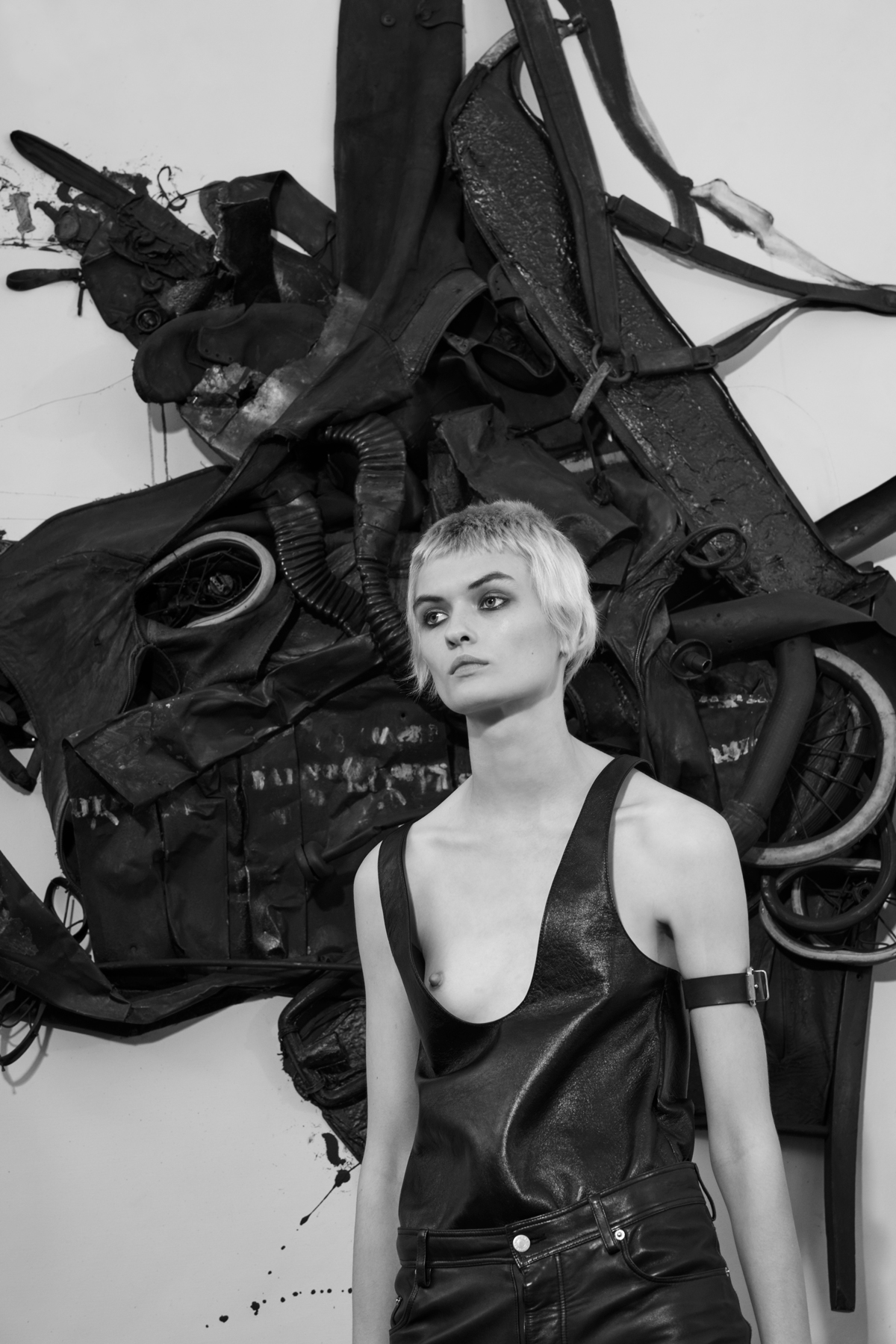
Lara wears Tank Top by Saint Laurent by Anthony Vaccarello. Pants by Maison Margiela. Armband by David Samuel Menkes.
“Hitchcock,” 1965.
RAINER: You were working your way out of cul-de-sacs.
GROSSMAN: You could say that about the head sculptures. The most powerful part of a human body is the head. The head is the sexiest part. It’s also the most dangerous part. You’d think the fist or the feet are, but no, it’s the head. I even made some sculptures that had teeth, because it was fascinating to me how you could do that. The truth is, my work comes out of the material. It’s about the mastery of the medium that I’m using, and while I’m working there’s a tension between me and the material—it’s always getting away from me, which makes it exciting. The result is always a big surprise.
RAINER: How do you know when to stop a particular work?
GROSSMAN: I don’t.
RAINER: Oh, that’s good, I guess. [Laughs]
GROSSMAN: It’s making itself, and when it looks like it’s complete, then I stop. Saying that, I know the head sculptures look purposeful. But I never make a preliminary sketch or model. It would feel too much like a commission and I’m bad at commissions.
RAINER: Let’s talk about “Male Figure” [1971], which you showed at the Met Breuer earlier this year. It’s larger than life, really.
GROSSMAN: It’s taller than me! It took me a whole year to make that one, because I had no idea how to make a sculpture.
RAINER: This figure is a man who’s both displaying his power and is bound to society.
GROSSMAN: And, as usual, he’s a chicken. But he has a suit over his feathers, you know?
RAINER: He’s afflicted. He’s railing against his conditions.
GROSSMAN: I made him as powerful and muscular and sexy as I could, front and back. In the museum, there was a little sign by him of a camera with a line running through it, meaning do not take pictures of this piece. I realized there would have been a lot of obscene selfies taken. There are a lot of misinterpretations about the work.
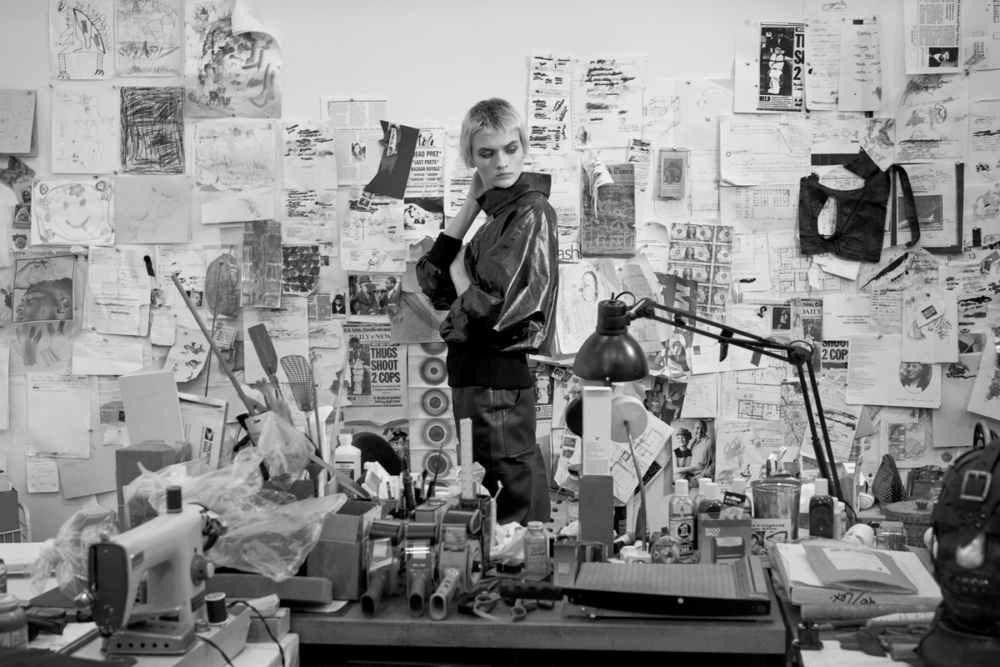
Lara wears Top by Givenchy. Pants by Eckhaus Latta.
RAINER: What are the misinterpretations?
GROSSMAN: My work is often taken in some superficial costume-y way. Other people think I’m simply interested in tying up people or beating them with chains or something. Nothing could be further from the truth. You know, I had a friend who took me to a leather bar back in 1961 or ’62. I didn’t know anything about it. But these people were the real thing—they were the real fetishists. There were a few young guys but most of them were older. I remember this very tall, angular man who was bald, and he was dressed in white leather. It was filthy. You could tell that he lived in it, you know? And now, here I am in Interview, which also started 50 years ago, the same time I began making my heads. If you told me I was going to do something for 50 years, I wouldn’t have believed it.
RAINER: Do you think Warhol influenced you in any way?
GROSSMAN: No. I was delighted by him and sometimes outraged by him, but I don’t think I was influenced by him. He was all shortcuts. I bet you that he was as surprised as I was, or you were, that he was celebrated in such an enormous way given that he started out doing line drawings for [the shoe company] I. Miller for years. They were humorous, nice drawings. They were commercial works, but you could tell he was having a good time.
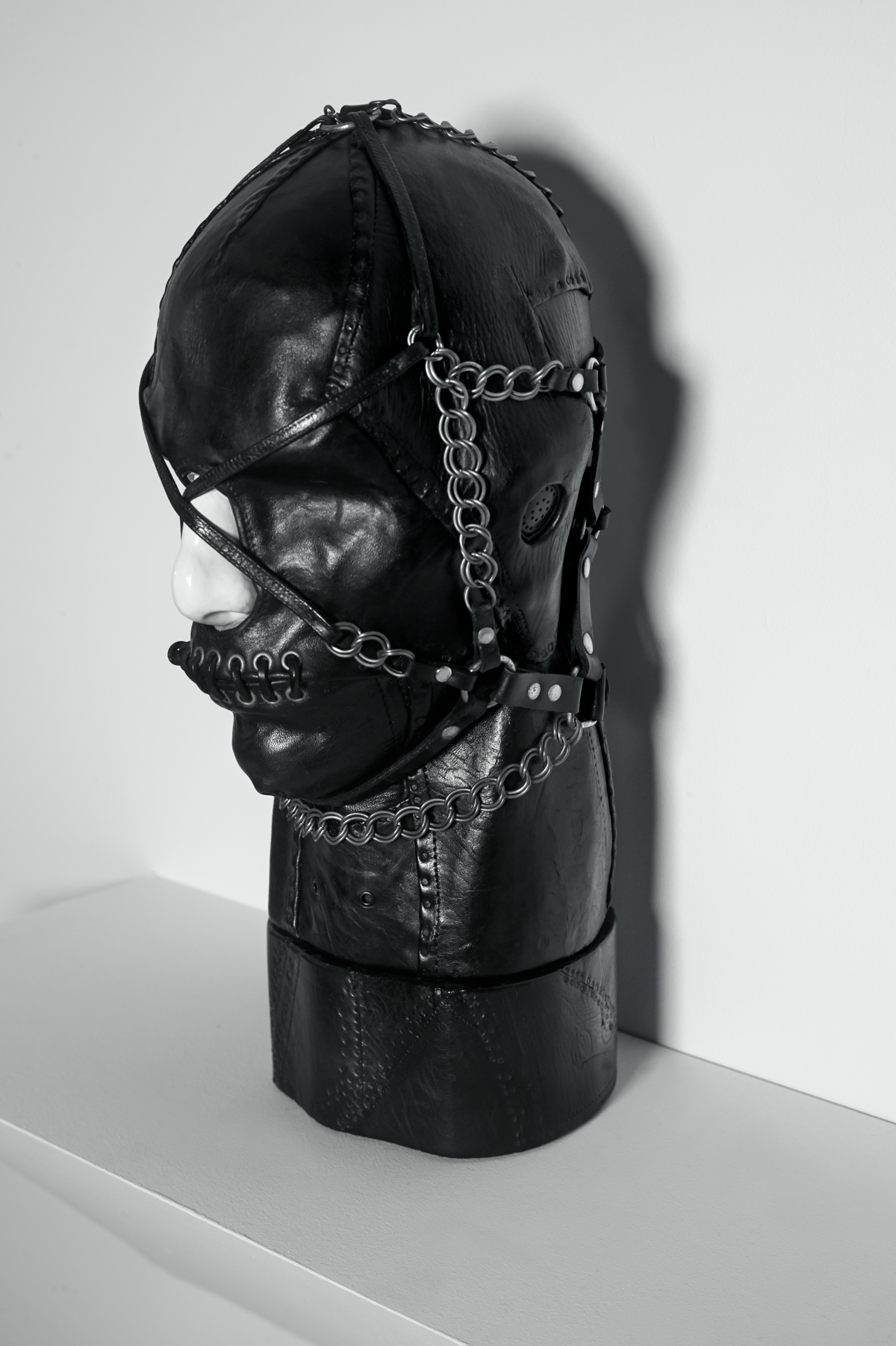
“Untitled,” 1968.
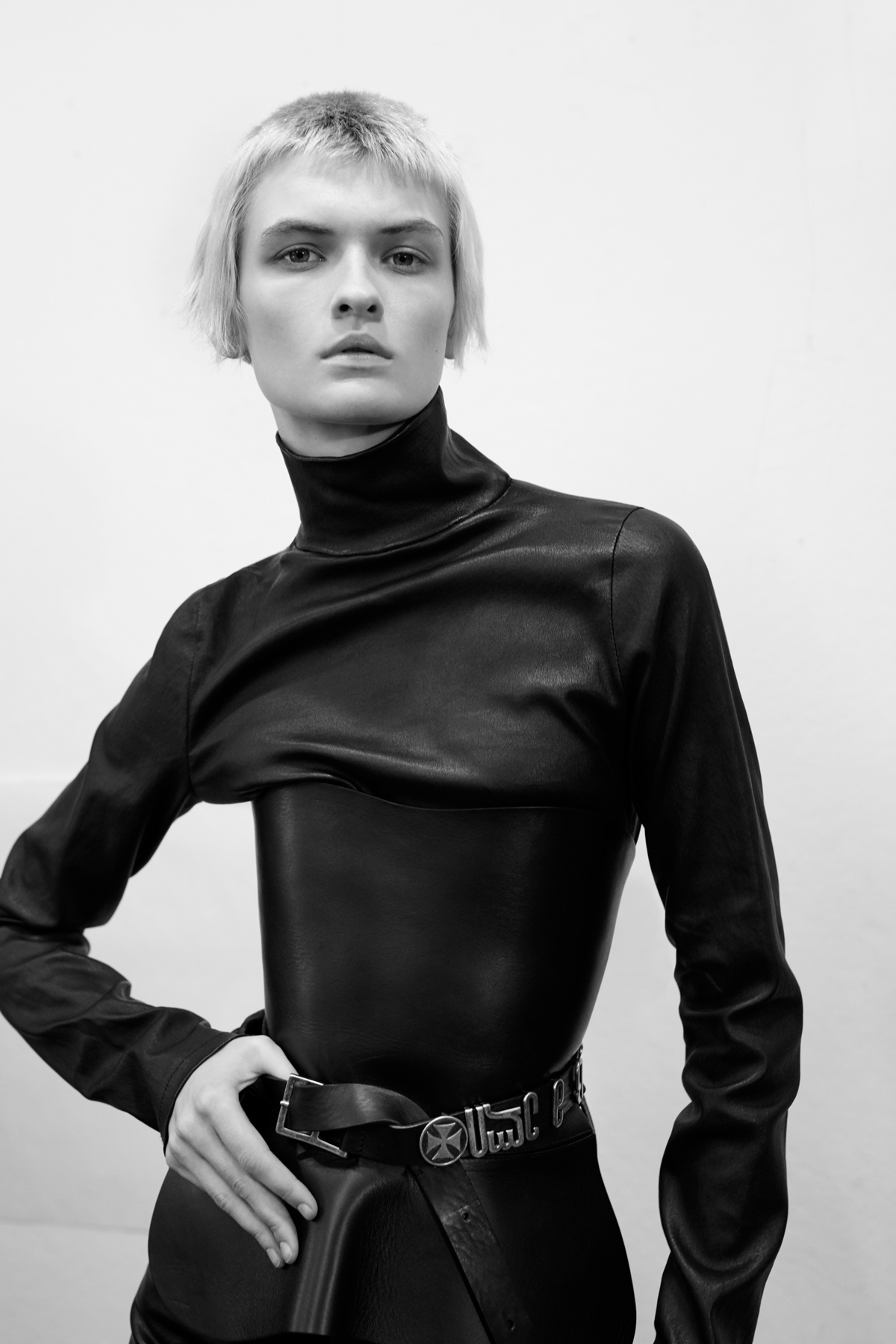
Lara wears Bustier by Dior. Turtleneck by Unravel. Pants by Kwaidan Editions. Belt by Vetements.
RAINER: Your paintings and collages are full of color, but your sculptures are very much black and white. Why is that?
GROSSMAN: I had a friend in the late 1960s who kept asking me if I was ready for a color television. I kept saying, “No, it will ruin me. Everything I do is black and white!” I wouldn’t hear of it. It would ruin my whole way of seeing in the world. All colors are contained in black and white just as all battles are contained in the head.
RAINER: Why are the noses on your heads white?
GROSSMAN: I didn’t want them to be misinterpreted as straightforward portraits or wooden sculptures. And I didn’t want anybody to think they were voodoo dolls. I wanted them to breathe and be free to exist. The noses are anti-organic somehow. Then I was free to add variety and variation to them. It became like doing a collage. Each one is different. I never let anybody see me make them, except for [Richard] Avedon, who took pictures of my studio in 1969—probably because I was flattered. He’s the only person I’ve ever let in.
RAINER: But now you’ve let Interview into your studio?
GROSSMAN: Yeah, and my gallery bought five head sculptures here and some flat work that had been sold many years ago. I was so happy to see some of them again.
———
Model: Lara Mullen at DNA Models
Hair: Holli Smith at Art Partner
Makeup: Dick Page at Statement Artists
Production: Eric Jacobson at Hen’s Tooth Productions
Digital Technician: Seth Mooney
Photography Assistants: Jahmad Balugo, Max Dworkin, PJ Spaniol
Fashion Assistants: Malaika Crawford, Dominic Dopico
Hair Assistant: Michiko Yoshida
Manicure: Maria Salandra at Vision Nation Artists
Post-Production: Two Three Two
Special Thanks: Halley Harrisburg, Hooper Turner, Michael Rosenfeld Art




